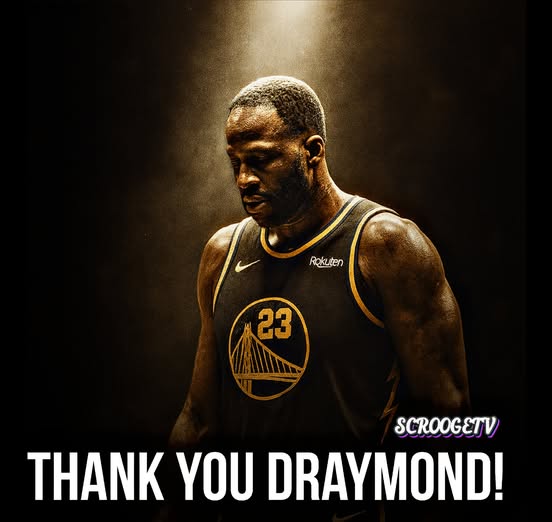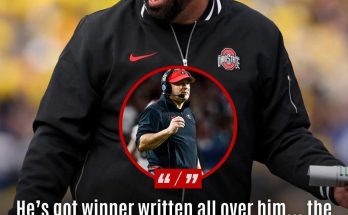Draymond Green, a name that has become synonymous with the Golden State Warriors’ dynasty, has officially announced that the upcoming NBA season will be his last with the franchise. After over a decade of blood, sweat, triumph, and controversy, Green’s decision marks the end of an era not just for the team, but for the NBA itself. A four-time NBA champion, a four-time All-Star, a two-time All-NBA Team honoree, and a two-time Olympic gold medalist, Green’s résumé speaks volumes, but it still doesn’t fully capture the unique essence of the player and person he has been throughout his career. As he steps into his final season, the basketball world finds itself in reflection—remembering how far he’s come, how much he’s given, and what the future might look like without him.
Draymond’s legacy cannot be evaluated merely through statistics. He has never been the kind of player to light up the scoreboard with 30-point performances night after night. Instead, his influence has always been measured in intangibles—deflections, stops, rotations, box-outs, and pure fire. He has been the emotional core of the Warriors, the vocal leader on the court and in the locker room, and the tone-setter on both ends of the floor. Green’s basketball IQ is elite, and his ability to anticipate plays, direct teammates, and act as a de facto point guard from the power forward or center position has made him indispensable. He isn’t just a player who fits within the system—he helped create it.
Green was drafted 35th overall in the 2012 NBA Draft, a second-round pick out of Michigan State who many believed lacked the physical gifts to thrive at the professional level. Too small to be a center, too slow to be a traditional forward, and not gifted enough offensively to carry a scoring load, Green came into the league surrounded by doubt. But he silenced his critics with an unmatched tenacity, defensive prowess, and a competitive streak that bordered on maniacal. What many saw as weaknesses, he turned into strengths. And once he got a chance to play significant minutes, he made sure never to look back.
The turning point came in the 2014-2015 season, when the Warriors—under first-year head coach Steve Kerr—embraced a small-ball revolution. Green’s ability to guard all five positions, initiate offense, and stretch the floor allowed Kerr to fully implement his vision of fluid, positionless basketball. That season ended with the Warriors hoisting the Larry O’Brien Trophy, and Draymond Green emerging as a star in his own right. He was no longer an overlooked second-round pick. He was a champion, a foundational piece, and arguably the best defender in the league.
Throughout the Warriors’ dynastic run—championships in 2015, 2017, 2018, and 2022—Green was the engine that made the team go. While Stephen Curry dazzled with transcendent shooting, and Klay Thompson terrorized defenders with his catch-and-shoot excellence, it was Green who handled the dirty work. He called out defensive assignments, controlled the pace, and delivered pinpoint passes in transition and the half-court. His chemistry with Curry, in particular, became legendary. Their two-man game, built on dribble hand-offs, screens, and misdirection, confounded opponents for years. And whenever the moment demanded it, Green was unafraid to speak up, often loudly and passionately.
Of course, Green’s fire occasionally burned a bit too hot. His career has been marked by technical fouls, suspensions, and headline-grabbing moments of friction—both with opponents and teammates. The most notorious of these came in 2016, when his postseason suspension for an accumulation of flagrant fouls arguably swung the NBA Finals in Cleveland’s favor. More recently, his altercation with Jordan Poole during a preseason practice raised questions about leadership, discipline, and accountability within the Warriors organization. Yet, for all his volatility, Green has always maintained that his passion is what drives him. And for better or worse, that passion has been inseparable from his greatness.
Even as he aged and his athleticism declined, Green adapted. He leaned even more into his defensive instincts, his knowledge of opponent tendencies, and his ability to orchestrate on offense without needing to score. In an era dominated by flashy stats and offensive explosions, Green remained a throwback—a player who could change the game with single-digit point totals and a plus-minus of +20. He was never afraid to be the villain, never too cool to dive for loose balls, and never shy about holding everyone—from rookies to superstars—accountable.
Off the court, Green built a reputation as one of the most outspoken and insightful voices in the sport. Whether on podcasts, postgame interviews, or guest analyst appearances, he has consistently demonstrated a deep understanding of the game. His ability to break down plays, speak candidly about league dynamics, and articulate the nuances of basketball strategy has made him a bridge between old-school and modern NBA minds. Many believe his post-playing career in media or coaching could be just as impactful as his time on the hardwood.
His decision to announce this as his final season with the Warriors brings a wave of mixed emotions to fans and analysts alike. There is gratitude for all he has done, but also a looming sense of loss. The idea of a Golden State team without Draymond Green feels incomplete, even unnatural. He has been there through it all—the rise, the glory, the collapse, the comeback. His fingerprints are all over the franchise’s history, and his presence has defined the culture. What happens next—whether he retires, joins another team, or shifts to a new role—remains to be seen. But what’s certain is that the chapter closing is monumental.
As the Warriors prepare for this farewell tour of sorts, there’s a sense of urgency and sentimentality. This isn’t just another season. It’s the final ride for a player who helped turn a good team into a historic one. There will be tributes, standing ovations, and countless highlights revisited. But knowing Green, he won’t want any of that to distract from the goal. His mind will be on winning, on squeezing every drop of effort and excellence out of his body one last time. That’s who he is—a competitor to the end.
There’s also a symbolic weight to Green’s departure. The core trio of Curry, Thompson, and Green has been one of the most successful in NBA history. With Thompson’s future uncertain and Curry edging toward the twilight of his career, this announcement signals that the dynasty is nearing its conclusion. Dynasties never last forever, but this one felt particularly special because of how interconnected its stars were—not just on the floor, but in spirit. Losing one of them changes everything.
But perhaps that’s the essence of sports—the inevitable march of time, the bittersweet transitions, and the legacy left behind. Draymond Green’s legacy is not just measured in banners, awards, or accolades. It’s measured in moments—the flex after a defensive stop, the bullet pass to a cutting teammate, the glare after a blocked shot, the roar that shook the Chase Center. It’s in the relationships he built, the rivalries he fueled, and the identity he helped forge.
To watch Green in his final season will be to witness the closing act of one of basketball’s most unique careers. He never fit into a mold, and that’s what made him special. As he steps away from the Warriors’ bench one last time, it won’t just be the end of a player’s tenure. It will be the farewell of a heartbeat, a soul, and a symbol of one of the NBA’s golden eras. Whatever happens next, Draymond Green will leave knowing he gave everything he had—and then some—to the team, the fans, and the game he loved.



